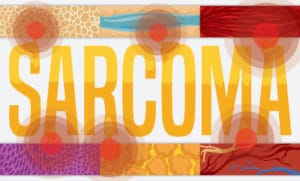July 1, 2022
July is National Sarcoma Awareness Month

July is National Sarcoma Awareness Month. Sarcoma cancer’s are an uncommon and rare group of cells, which arise in bones, connective tissues, fat and muscle. They can affect almost any part of the body, inside or out. The main regions that Sarcoma Cancer cells typically affect, include the arms, legs and trunk area. Sarcoma cancer’s appear in the stomach and intestines as well as behind the abdomen (retroperitoneal sarcomas) and the female reproductive system (gynaecological sarcomas).
Soft tissue sarcomas can affect any part of the body. These develop in the supporting connective tissue, such as your nerves, fatty tissue and blood vessels.
These soft tissue sarcomas include:
GIST – a common sarcoma developed in the gastrointestinal (GI) tract. The GI tract acts as a long tube, running through the body from the oesophagus to the anus (back passage) and includes the stomach and intestines.
Gynaecological Sarcomas – Occur in the female reproductive system; the uterus (womb), ovaries, vagina, vulva and fallopian tubes. Gynaecological Sarcomas can affect women of any age.
Retroperitoneal Sarcomas – These types of sarcomas occur in the retroperitoneum, an area behind the peritoneum which is the lining of the abdominal space that covers the abdominal organs. Organs located in this region include major blood vessels, kidneys, pancreas and bladder.
Sarcoma Five Facts
- Sarcomas makes up about 15 percent of all childhood cancers (0-14) and 11 percent of all cancer diagnoses in teenagers and young people (15-24) years of age.
- Soft Tissue Sarcomas are rare. Labeled the “Forgotten Cancer”, Doctors diagnose about 13,000 new cases each year.
- Sarcomas can be difficult to diagnose. Most noticeable symptom may be a small, painless lump. These lumps can be overlooked or even misdiagnosed.
- Surgery remains the main treatment for most soft tissue sarcomas.
- 60 percent of soft tissue sarcomas are localized at the time of diagnosis. For these types of cancers, the five-year relative survival rate is high at 81 percent.
Early detection is required for the best possible survival outcomes. Treatment is most effective before the spread of the sarcoma to other areas of the body. It’s vital that patients are referred to a specialist as early as possible.
To make sure you are caught up with all of your health care screenings, schedule an appointment with your Primary Care Provider or find one HERE.
